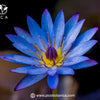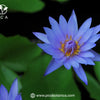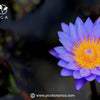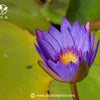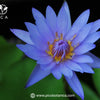Blue Lotus Tea and Its Connection to Ancient Egyptian Spirituality
- by Ritika Rajan
In a world rediscovering ancient plant wisdom, Blue Lotus Tea stands out not only for its calming effects but for its rich spiritual history. This sacred flower, known botanically as Nymphaea caerulea, once bloomed along the banks of the Nile, where it became deeply entwined with Ancient Egyptian rituals, mythology, and consciousness.
Today, the tea made from Blue Lotus petals is enjoyed as a calming tonic—but beneath the gentle floral taste lies a legacy of mysticism, spiritual awakening, and inner vision that dates back millennia. This article explores the historical, spiritual, and energetic dimensions of Blue Lotus Tea, connecting the dots between ancient Egyptian practices and modern-day wellness seekers.
What Is Blue Lotus?
Before diving into the spiritual connections, let’s understand what Blue Lotus is:
Scientific name: Nymphaea caerulea
Common names: Blue Lotus, Sacred Blue Lily of the Nile
Plant type: Aquatic flowering plant native to Egypt and parts of East Africa
Appearance: Sky-blue petals with a golden-yellow center, often floating atop water
Despite being called a "lotus," it’s technically a water lily. Still, its status as a sacred symbol...
The Role of Blue Lotus in Ancient Egyptian Culture
Blue Lotus wasn’t just admired for its beauty. It played a profound role in the cultural, spiritual, and even political life of ancient Egypt. Here’s how:
1. Symbol of the Sun and Rebirth
The Blue Lotus opens in the morning and closes at dusk—a perfect metaphor for rebirth.
In Egyptian mythology, the sun god Ra was believed to have emerged from a Blue Lotus at the beginning of time.
The flower became a visual metaphor for the journey of the soul, the daily resurrection of the sun, and the idea of eternal life.
2. Ritual and Religious Use
Blue Lotus was used in ceremonial offerings, especially in temples dedicated to Osiris and Hathor.
It was often depicted in art hovering above chalices or adorning altars.
Priests and initiates drank infusions of Blue Lotus to elevate their consciousness during rituals.
3. Burial and Afterlife Practices
Blue Lotus flowers were found among the burial items of pharaohs and nobles, including the famed tomb of Tutankhamun.
The presence of the flower symbolized spiritual awakening in the afterlife and protection on the soul’s journey.
Blue Lotus as a Consciousness Expander
The ancient Egyptians didn’t just revere the Blue Lotus for symbolic reasons. They used it as a psychoactive plant, one that had mildly euphoric, dream-inducing properties.
Reported Effects of Blue Lotus:
Enhanced introspection and lucid dreaming
Emotional tranquility and heart-opening sensations
Elevated states of spiritual awareness
Mild euphoria or body relaxation
Modern science suggests these effects are due to active compounds like apomorphine and nuciferine, which interact with dopamine receptors and may influence mood, perception, and dream states.
While its effects are subtle compared to modern pharmacological substances, ancient initiates seemed to value Blue Lotus for its ability to shift the mind toward the mystical.
The Spiritual Role of Blue Lotus Tea
Blue Lotus Tea, brewed from the dried petals or whole flowers, is believed to carry not just the plant’s physical properties but also its energetic and spiritual essence.
Here’s how it aligns with spiritual practices today and possibly in ancient times:
1. Heart Chakra Activation
Many users report that Blue Lotus opens the heart chakra (Anahata), fostering feelings of love, empathy, and compassion.
This aligns with its use in Hathor temples, where joy, sensuality, and divine love were honored.
2. Meditation and Dreamwork
The tea’s calming and mildly psychoactive effects make it a favorite among modern meditators, yogis, and lucid dreamers.
Ancient Egyptian priests likely used it in similar ways—to enhance trance states, visions, or dream interpretations.
3. Divine Feminine Connection
Blue Lotus is strongly associated with the divine feminine in Egyptian spirituality, particularly the goddess Isis.
Drinking the tea can be part of rituals that honor feminine energy, intuition, and inner wisdom.
Blue Lotus in Egyptian Mythology
A number of key Egyptian myths feature the Blue Lotus as a central or symbolic element:
1. Creation Myth of the Lotus
In the Hermopolitan cosmology, the world began in a watery chaos known as Nun.
From these primordial waters, the first Blue Lotus rose, opening to reveal the infant sun god Ra, bringing light and order.
2. Osiris and Isis
Blue Lotus was used in ceremonies honoring Osiris, god of the underworld and rebirth.
Isis, his consort, was believed to use the flower’s magical properties in her resurrection rituals.
Symbolically, the flower represents the eternal cycle of death and rebirth—a central theme in the Osirian mystery schools.
Preparing Blue Lotus Tea Today
To reconnect with this ancient plant ally, many modern spiritual seekers and herbalists enjoy it as a tea. Here’s how to prepare it traditionally:
Ingredients:
1–2 dried Blue Lotus flowers or 1 heaped tsp of petals
1 cup hot (not boiling) water
Optional: raw honey or cinnamon
Brewing Instructions:
Heat the water to about 80–90°C (175–195°F). Avoid boiling to preserve delicate compounds.
Place the flower(s) in a cup or teapot and pour hot water over it.
Steep for 5–10 minutes, watching as the petals unfurl.
Strain and sip slowly, ideally in a quiet or sacred space.
Ritual Ideas Using Blue Lotus Tea
Here are a few modern spiritual practices that mirror ancient intentions and can be enhanced with Blue Lotus Tea:
1. Sunrise Meditation
Drink Blue Lotus Tea as the sun rises to symbolize spiritual rebirth.
Meditate on the light within, as the ancient Egyptians did with the image of Ra.
2. Dreamwork or Sleep Ritual
Consume the tea 30–60 minutes before bed.
Set an intention to receive insights in your dreams.
Keep a dream journal nearby to capture morning reflections.
3. Moon Ceremonies or Goddess Rituals
Use Blue Lotus Tea in new moon or full moon circles.
Dedicate the practice to Isis or Hathor, calling in feminine wisdom, beauty, and divine grace.
Modern Benefits of Blue Lotus Tea
While its ancient spiritual significance is compelling, Blue Lotus Tea also offers several modern wellness benefits:
Physical & Emotional Benefits:
Relieves tension and mild anxiety
Supports restful sleep
Promotes emotional clarity
Mild aphrodisiac effects
Can support menstrual comfort and balance
Many wellness seekers report that Blue Lotus is not just relaxing—it feels deeply nourishing, even sacred. This mirrors how the ancients perceived it: not just a plant, but a portal to the divine.
Ethical and Energetic Considerations
Because Blue Lotus is not a common commercial crop, it’s important to ensure that your source is:
Organically grown
Wildcrafted responsibly, without harming natural ecosystems
Hand-harvested and dried naturally, preserving its energy
Energetically, some practitioners recommend charging your Blue Lotus flowers under moonlight or sunlight, depending on your intention—just as ancient Egyptians would leave offerings exposed to the elements to empower them.
Why Blue Lotus Resonates Today
At a time when people are seeking to slow down, reconnect with the natural world, and rediscover spiritual practices that feel authentic, Blue Lotus offers:
A non-psychoactive, gentle way to shift consciousness
A ritual tool that bridges ancient wisdom and modern self-care
A reminder that spirituality can be both sensual and sacred
Final Thoughts: Drinking in the Mysteries
Blue Lotus Tea is more than a beverage—it is a link to one of the world’s most spiritually advanced civilizations. The Egyptians didn’t just admire its beauty; they drank it to awaken, to commune with the gods, and to explore consciousness.
In your own practice, drinking Blue Lotus Tea can be an invitation to:
Awaken your inner light
Deepen your connection to ancient wisdom
Enter sacred space in body and mind
As you sip this sacred flower, you’re not just tasting history—you’re participating in it.
At Pico Botanica, we source ethically harvested, whole Blue Lotus flowers—just as the ancients once did. Our premium Blue Lotus is sun-dried, spiritually potent, and ready to infuse your rituals with divine calm, clarity, and connection.

